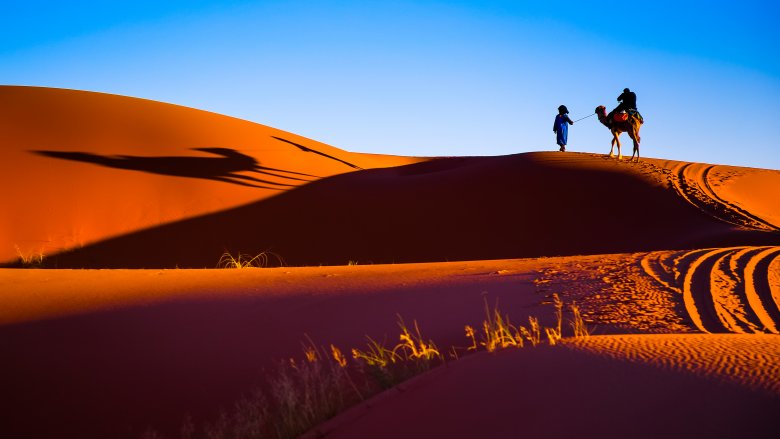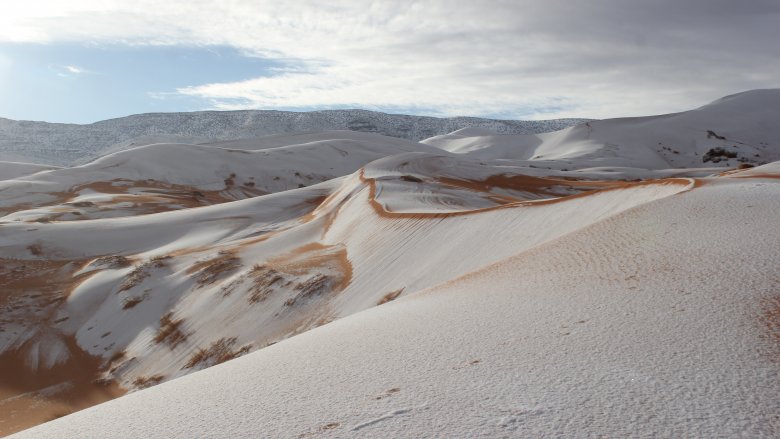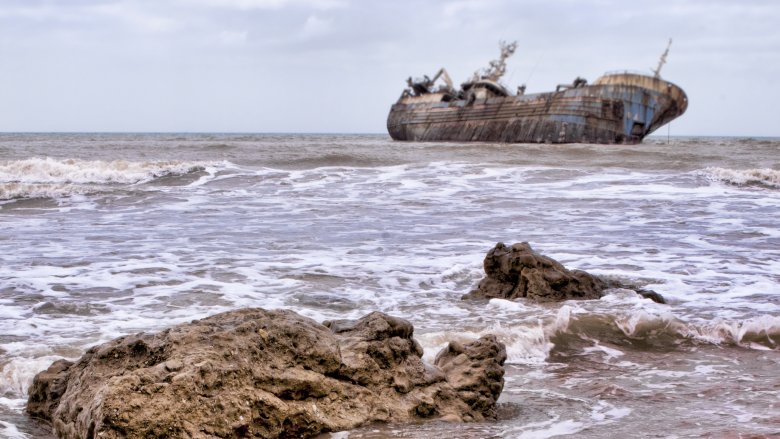Craziest Things To Happen In The Sahara Desert
The Sahara desert is sometimes romanticized and sometimes villainized, but human beings will probably never lose their fascination with this 3.5 million square mile wasteland that stretches 3,000 miles in length across 10 countries and an entire continent. The Sahara is one of the harshest and least hospitable places in the world. Even though it has more than 20 lakes, only one of them contains water you can drink. The rest are full of brine. Average annual rainfall across the desert is roughly equal to the amount of water that comes out of your shower on a Friday morning. And temperatures are frequently well over 100 degrees Fahrenheit, which seems really darn hot unless you've also experienced a summer in Los Angeles.
Despite the fact that logic warns against ever going within 500 miles of the place, people not only live in the Sahara desert, they also visit it ... on purpose. It's not just the extremes of weather that make the Sahara one of the craziest places on Earth, it's also the experiences of the people who live and run marathons there.
Climate change ... for the better
Yes, the Sahara desert is a hot, inhospitable place. You probably think it's always been that way, and it has. Mostly. But the really crazy thing about the Sahara is that it had an identity crisis about 10,500 years ago. Because it couldn't get a divorce, buy a sports car, and date younger women, it just decided to give itself a face lift.
For several thousand millennia, the Sahara was wet and green. According to LiveScience, a "sudden burst of monsoon rains" drenched the land and turned the Sahara into a place where people could not only live, but raise livestock. Vegetation found a foothold there, wild animals moved in, lakes formed, and people built permanent settlements.
And then between 7,300 and 5,500 years ago, the rains stopped, the desert dried up, and the identity crisis was over. Maybe the Sahara's younger, hotter girlfriend ended their relationship. Or, more likely, humans messed everything up. Archaeologist David Wright believes the young grasslands were simply overgrazed by the settlers' livestock, which increased the amount of reflected sunlight, which triggered a reduction in monsoon rainfall. That set off a cause and effect loop — less rain meant less vegetation, which in turn meant less rain, and eventually the desert gave up its sports car and settled back into its old ways. It had a pretty good run while it lasted, though.
It snowed
If there's anything you can be sure of in life, it's that death is coming, the taxman will eventually find you, and it never snows in the Sahara. Except for all the times it totally did.
According to CNN, in December 2016 a "freak snowfall" hit the town of Ain Sefra in Algeria for the first time in 37 years. The town is in the Sahara desert but it's 3,537 feet above sea level, which would put it in the snow zone in most other parts of the world. However, because it's also one of the hottest places in the world, snow just doesn't happen there.
After that first storm was over, everyone said, "That was weird," took a bunch of photos, and then went on living their lives. Then in 2017 another snowstorm hit the area, dropping enough of the white stuff for snowmen and sledding. And in 2018 it happened again, prompting some people to wonder if winter snowfall in the Sahara desert might actually be the new normal. As the climate changes, the odd weather patterns that made snow possible in Ain Sefra might start to become commonplace, and then the words "it snowed in the Sahara" won't really seem weird or newsworthy anymore. Ain Sefra probably won't open any ski resorts, but it's possible that shopkeepers may one day do a brisk trade in plastic snow saucers.
Stranded marathoner survives on urine and bat blood
This sounds like the plot of a movie no one would go see, sort of a cross between a really backward teenage vampire movie and Ben Hur. But it's not the plot of a movie — it's something that actually happened.
According to the BBC, 39-year-old Mauro Prosperi was competing in the 1994 Marathon des Sables, a six-day marathon that crosses the Sahara desert. Four days into the race, he got caught up in a sandstorm. Late the next morning he realized he was lost and started peeing in his spare water bottle, just in case. Eventually he found a Muslim shrine with a bunch of bats roosting in it, so he caught them, cut off their heads, "mushed up their insides," and drank their blood. Like Dracula only in reverse.
Just when you thought this story couldn't get any more awful, Prosperi knew he was in for a slow and painful death, so he cut his own wrists hoping to speed up the process. But because of the dehydration, his blood was too thick to drain.
He started walking again. He drank his own urine. He killed snakes and lizards and ate them raw. And after he was rescued, he was mostly just bummed because he didn't finish the stupid marathon. As of 2014, Prosperi has run the Marathon des Sables seven times, placing 12th in 2001. Because some people just don't know when to quit.
Adventure on the high Sahara
If you shipwreck in the modern world you've at least got a hope of eventually being rescued by the Coast Guard. But in the golden days of seafaring, being in a shipwreck usually meant death, and the only real question was how long it was going to take.
According to National Geographic, in 1815 an American ship called Commerce ran aground on the northwest African coast, which was quite possibly the world's suckiest place to be shipwrecked, mostly because of the desert nomads who were rumored to eat any shipwrecked sailors they didn't sell into slavery. The crew tried to escape from those dangerous shores in a longboat, but ended up turning back, getting captured by Bedouin slave traders, and being forced to cross the Sahara.
Fortunately the ship's captain was a pretty resourceful dude, and he convinced a desert trader to purchase himself and four crew members, which must have really stunk for the remaining crew members, but you do what you gotta when you're half starving and dying of thirst. The desert trader agreed to take them north where they could be ransomed to their families and roughly two years after the wreck they finally reached safety. Then Riley wrote a best-selling book about the experience, which is what everyone in America does after a harrowing experience, so despite the slave trading and the shipwrecking, times were really not so different after all.
Really awesome dinosaur bones
Dinosaurs roamed jungles and vast grasslands and fictional amusement parks, but no one ever CGIs footage of dinosaurs trudging through the desert. Fun fact: Dinosaurs did live in the desert — velociraptor is perhaps the most famous desert-dwelling dinosaur — but for some reason that particular visual never caught on.
The Sahara wasn't a desert back then, though, it was tropical, and dinosaurs lived and thrived there. But for some reason, the Sahara of today is not known as a paleontologist's treasure trove — it's rare to find dinosaur bones there at all, let alone nearly intact whole skeletons. That's why it was so surprising to find an almost-complete skeleton of a plant-eating dinosaur called Mansourasaurus shahinae in the desert of modern Egypt.
According to USA Today, this particular dinosaur, whose name is way too long to type twice, was about the size of a school bus and is an important find because it's rare to discover dinosaur fossils in the Sahara but also because it's the most complete dinosaur from the end of the Cretaceous ever discovered in the area.
Cutest thing to happen in the Sahara
This one isn't super crazy, but if you need a break from all the urine-drinking, slave-trading, and headless bats, now is your time. According to Earth Touch News Network, in October 2017, researchers captured rare footage of wild sand cat kittens in Morocco's part of the Sahara. What is a sand cat kitten, you ask? Picture the cutest thing ever. And then give it huge eyes and huge ears.
To call sand cats "elusive" would be like saying that republicans and democrats have different opinions. Sand cats are hardly ever observed in the wild, and when they are no one ever films them because they can't stop gawking long enough to actually get their cameras out. Sand cats look similar to house cats, but they're smaller and generally sand-colored. Like house cats, sand cats use the wilderness version of a litter box, which means researchers don't even get to poke around in their poop, which must be pretty crushingly disappointing since researchers just love poking around in poop. Sand cats also don't leave footprints because like house cats, sand cats can teleport. (Or they have specially adapted feet — could be either one.)
So there you have it, a positive reason to visit the Sahara and a story that is not horrifying and depressing. Onward.
The hottest, suckiest gold rush anywhere, ever
The story goes like this: Someone accidentally discovered gold. Thousands of people rushed to the scene in the hope they would find gold, too. Except this time we're not talking about California, but about a new gold rush in what is possibly the world's most sucky place to have to dig a hole: the Sahara desert.
No one knows the actual story about how gold was discovered in Niger's part of the Sahara, because such stories benefit from exaggeration so most tellers don't waste any time exaggerating them. According to Vice, one version says the discoverer was a goat herder who found an odd-looking rock and asked his friend to help him identify it. Evidently his friend did not say, "That's a piece of quartz, let me take it off your hands," which would make it a more realistic story, but instead told him that he'd found a gold nugget, which was later valued at $1,400. That's roughly three times what most people in Niger earn in a year, by the way.
Word got out, people flocked to the area, and then the gold rush proceeded as gold rushes generally do, with a few people getting rich and most everyone else getting disappointed. Except if you don't strike it rich in the Sahara, you're still in the Sahara. During the California gold rush, you could at least throw up your hands and go to the beach.
Hottest place on Earth?
California and the Sahara are rivals for the title "most sucky gold rush of all time," and they're also rivals for the title "hottest, most sucky temperature of all time." According to Climate Central, on July 10, 1913, California's Death Valley hit 134 degrees Fahrenheit. Not to be undone, in 1922 Libya recorded a temperature of 136.4° F in the Sahara Desert at El Azizia. The record stood for 90 years, until Guinness World Records called B.S. and gave the title back to California.
Evidently this was a controversy because meteorologists don't really get to argue about anything cool so they might as well argue about the length of their mercury rods. El Azizia is close to the Mediterranean Sea, so you wouldn't really expect to see temperatures that hot, and surrounding regions recorded temperatures as much as 18 degrees cooler that day, so it seemed pretty unlikely that a freak heat wave would have struck just that one town.
None of that means the Sahara isn't really, really hot, though. The world record for "most reliably measured temperature" in Africa was 123.3° F, which was set at Semara in the Western Sahara in July 1961. And keep in mind that meteorologists can only measure temperatures in places where there's a weather station — it's actually pretty likely that the Sahara not only exceeds that temperature in some places, but does so on a regular basis.
The Iron Man motorcycle
When Tony Stark was captured by terrorists in the desert of Afghanistan, he built an Iron Man suit and exploded everything. When Emile Leray was stranded in the desert of Morocco, he built an Iron Man motorcycle. This story would be cooler if Leray had also somehow exploded everything with his Iron Man motorcycle, but you can't have it all.
In 1993, Leray got the bright idea to go on a road trip across the Sahara in a Citroen 2CV. If you aren't familiar with the Citroen 2CV, here's the rundown. It's about the slowest car in the world and quite possibly also the ugliest. Anyway, Leray went off road in his very slow, ugly car, crashed it, and then probably deeply regretted his decision to drive a Citroen 2CV across the Sahara.
Instead of sitting around waiting for someone to rescue him, though, The Vintage News says Leray took his car apart and used the parts to build a motorcycle, a project that took 12 days. By the time he finished he was down to around 16 ounces of water but was miraculously able to drive away from the wreck. Moroccan police picked him up about a day later, and then fined him because his registration documents were for a Citroen 2CV and not an Iron Man/Mad Max motorcycle. Lucky for them, Leray chose not to explode them, though that would have made a very fine Marvel film.
A 700-mile dust storm
Dust storms are familiar to everyone who has ever seen any fictionalized account of life in the Sahara, ever because dust storms are super dramatic and fun. To watch. Being caught in an actual dust storm is considerably un-fun — just ask Mauro Prosperi. While you might complain when one of those mini-twisters flings dirt into your face, just imagine if that mini-twister was hundreds of miles long and lasted for 12 hours.
In May 2011, NASA captured a photograph of a dust storm said to be 700 miles in length. Just to put that into perspective, that's about 40 miles wider than the state of Texas.
So what's the deal with all the dust in the Sahara? Well for a start, nothing is really holding all the sand and dust in place. There aren't any roots to keep the ground together because nothing grows in the Sahara. And there's hardly ever any water, so the ground doesn't get packed down into mud, either.
Because the Sahara is so hot, the air at ground level is unstable, so it has a tendency to fling dust particles up in the air, just for fun. So when the desert decides to have a party, 700-mile dust storms form, people get lost in the desert, and the bats are all, "We'd better get out of here before that guy with the bottled pee shows up."




